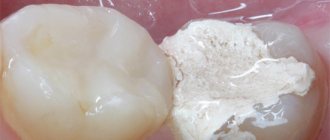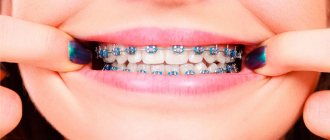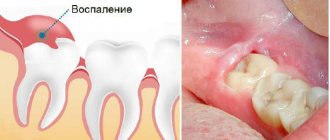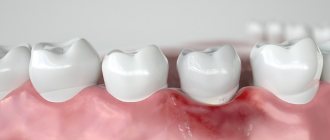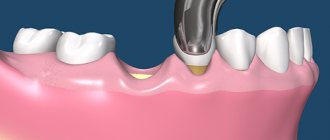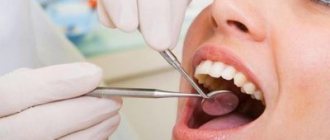24.11.2019
An allergy is an increased sensitivity to certain substances that causes painful symptoms. An allergy to a filling is quite rare, but still, each human body is special, and can react differently to a filling composition that is foreign to it. Any material introduced into the human body from the outside can cause a toxic reaction.
How does an allergy to a filling manifest itself and what can it be confused with?
An allergic reaction to a filling is manifested by redness and swelling of the gums, aching pain, and an atypical taste in the mouth. But these symptoms may indicate the consequences of treatment (especially if it was carried out with the removal of a nerve or surgical opening of the gum), and an allergy caused by an anesthetic medication. In these cases, the unpleasant sensations disappear within a few days, usually two or three, less often a week.
If pain, redness and swelling do not subside over a longer period of time, this indicates an allergy to some component of the filling material. Symptoms may subside when taking an antihistamine (anti-allergy) drug, but then appear again - because contact with the allergen does not stop. Moreover, the symptoms worsen, possibly an increase in body temperature, the appearance of a rash and itching, and the spread of swelling to the facial area.
How can you identify allergies before filling?
It is difficult to find out about an existing allergy to dental material, since this topic is poorly studied. The only way out is skin testing. To do this, take the material that will be used to install the filling, tie it with a thread to the wrist and leave it for a day. The appearance of itching or redness indicates the presence of an allergic reaction. It is important to understand that this experiment does not provide a 100% guarantee of veracity.
Regarding the manifestations of allergies, they can appear immediately or after a certain time.
Allergy test for dental materials
But if there are any signs of it, you need to contact dentistry (to remove the structure) and an allergist (to identify the cause of this reaction).
The main thing is not to delay so that the condition does not worsen.
It should be understood that even if you have an allergic reaction to one type of filling material, you can opt for another material (even of lower quality). A professional dentist will find a solution to dental problems in any situation.
Allergy to temporary filling
A temporary filling is installed for a period of several hours to 2-3 weeks, mainly for diagnostic purposes - to determine how infected the pulp (neurovascular tissue of the tooth) is. If pain persists after placing the filling, then the dental nerve is inflamed and is removed. Also, a temporary filling can be intended to fix a medical lining in the dental cavity.
For temporary filling, dentists use mineral cements of various compositions, polymer one-component pastes, and dentin paste. Each component of the materials can cause an allergy, although the likelihood of this is very, very small. In any case, when replacing the temporary filling with a permanent one having a different composition, contact with the possible allergen will stop.
What should be done
The first thing you need to do is make an appointment with your dentist immediately. If dentures are removable, they must be removed from the oral cavity. If the symptoms are serious, for example, the patient has difficulty breathing, then an ambulance should be called immediately.
At the dentist’s appointment, the doctor must remove the dentures, if they cannot be removed independently, and prescribe a series of diagnostic tests. Blood tests and various allergy tests will help determine the exact cause of the allergic reaction. In the future, the issue of replacing prostheses with hypoallergenic ones is being resolved.
Additionally, consultation with an allergist may be required.
Allergy to permanent filling
A permanent filling, if done well by a dentist, will last for many years and even decades. A wide variety of materials are used for fillings - from phosphate cement, usually used in the provision of free dental care, to the most modern light-curing composites of complex composition. And not a single filling material, cheap or expensive, unfortunately, excludes allergies. Despite the fact that entire corporations are trying to develop a completely hypoallergenic composition for fillings, the ideal does not yet exist. The individual reaction of the body is unpredictable.
Types of materials for fillings
What specific components can cause an atypical reaction in the body? The material that often causes allergies is amalgam. It is an alloy of mercury with silver and other metals, now used very rarely, despite its strength. This filling material has lost its position not only because of toxicity - contrary to popular belief, amalgam does not release dangerous amounts of mercury into the human body, it is quite safe. But too many allergic reactions to it have been recorded, and an atypical reaction does not appear immediately (the so-called “delayed” symptoms), but an allergy to metals is one of the most severe. In European countries, the use of amalgam in dentistry is prohibited.
Gold fillings are also a metal alloy; an allergy to such a filling is possible, but it is extremely rare.
A filling made of acrylic plastic (methyl acrylate), a material that not so long ago was considered the newest alternative to metals. But now acrylic plastic is rarely used by dentists, it is short-lived and toxic, and in terms of the number of allergic reactions it surpasses all filling materials - approximately a third of patients had an atypical reaction to this material.
Chemical-curing composites are obsolete, developed in the 70s of the last century, but, along with cement fillings, they are used in free dentistry. The composition of synthetic resins and quartz powder is mixed immediately before installation in the oral cavity and hardens within a few minutes. Resin, which is an artificial material, is a strong allergen.
Light-curing (photopolymer) filling is a composite that hardens under an ultraviolet lamp. This material, which appeared in dentistry relatively recently, consists of a polymer, a mineral filler (glass ceramic or silicon dioxide) and a binder. Manufactured to meet hypoallergenic requirements. The American Dental Association has recorded only a few dozen cases of allergies to light fillings - this is a tiny percentage of the number of patients treated.
Ceramic (porcelain) filling. Ceramics is considered completely hypoallergenic, or, as cautious doctors say, a material to which no allergies have been observed. But a ceramic filling, or inlay, is glued to the tooth with adhesive glue and fixed with composite cement, and these materials are possible allergens.
Allergic diseases in dentistry
Allergic diseases in dentistry are of the same nature as all other types of allergies. Allergies can occur to absolutely anything, at any age, and nowadays even allergies in infants are not uncommon.
When an allergic reaction begins, the body specifically begins to react to the irritant substance. Among the main manifestations of allergic reactions in dentistry are skin itching, tearing, coughing, choking and even anaphylactic shock. Also, with allergies in dentistry, the delicate mucous membrane of the oral cavity suffers greatly, and allergic stomatitis can develop - inflammation of the gums caused by an allergen.
Types and causes of allergies in dentistry
Depending on the nature of the allergens and the causes of allergies, the following types of these diseases are distinguished:
Drug allergy is a pathological reaction of the patient’s body to medications. Allergies can also occur to bleaching agents during professional bleaching. But most often in dentistry, allergies are observed to anesthesia drugs.
Before administering (or applying) the drug, a professional anesthesiologist will ask what medications you are taking and how long ago you drank alcohol. It will also find out what kind of anesthesia you used before for dental treatment. All this data will help you choose the safest drug possible.
If a sad experience has suggested which drugs are causing your allergies - antibiotics, anesthetics, painkillers, and so on - make sure that this information is included in your hospital card. And it’s better in a prominent place right on the cover. This beacon will force the doctor to be more careful in choosing medications. If you have already had allergic manifestations more than once, be sure to ask what medications will be used in your treatment.
Contact allergies occur when the mucous membrane of your mouth comes into long-term (or short-term) contact with the surface of a filling or denture. In addition to the usual manifestations of allergies (tearing, coughing, choking), specific contact allergic stomatitis may occur. This disease is characterized by painful conditions of the oral mucosa - swelling, burning and itching, and the appearance of wounds.
Contact allergies can be caused by dentures made from a variety of materials – both plastics and metals. Often the culprits of allergies are old, decaying dentures. But sometimes the problem is not the material of the prosthesis, but insufficient care for it and poor oral hygiene. In such a situation, pathogenic bacteria can multiply under the prosthesis. The products of their vital activity become a strong allergen.
In very rare cases, even the gloves the doctor wears can cause a contact allergic reaction. Allergy to latex is a rare but common phenomenon.
First aid and treatment for allergies
In case of an unexpected allergic attack and anaphylactic shock, any dental office is equipped with an emergency anti-shock first aid kit. The clinic’s doctors can provide the first and most necessary aid without fail until the ambulance arrives.
Allergic diseases in dentistry are treated according to a scheme common to all allergies: isolation of the irritant - taking an antihistamine - measures to prevent the disease.
So, if you have a contact allergy to a denture, the first and important step is to have it removed in a professional dental clinic. At the same time, you need to start taking anti-allergy pills. You can also use antihistamine gels and ointments; there are plenty of them in modern pharmacies. Prevention in this case will be the installation of a new prosthesis made of hypoallergenic material and proper care for it.
Among the preventive measures for allergy sufferers are the exclusion of allergenic foods from food: citrus fruits, chocolate, seafood, as well as stopping the uncontrolled use of pills and mixtures without consulting a doctor.
It is not always possible to quickly identify the causes of allergies. In such cases, it is worth carrying out a complete sanitation of the oral cavity. It would not hurt to consult a gastroenterologist to rule out gastrointestinal diseases.
In addition, today the patient can conduct allergy tests for filling material or anesthetic in advance, so as not to encounter unwanted allergies later.
Signs of allergies can also be taken as manifestations of completely different diseases. Thus, stomatitis manifests itself not only in an allergic form, but also due to serious diseases of the internal organs. Do not make a diagnosis yourself - go to a clinic, where an experienced doctor will find the cause of your ailments and prescribe a comprehensive step-by-step treatment.
What to do if you suspect an allergy?
Do not self-medicate, do not use traditional medicine methods that are useless in this case. Constant exposure to an allergen can cause serious complications.
If pain and swelling persist, consult a dentist and rule out the possibility of an inflammatory process associated with dental intervention. If the dentist, after examining the oral cavity, confirms that the treatment was carried out correctly and the symptoms are not related to the manipulations performed, it is necessary to visit an allergist-immunologist to take a test to sample the filling material used for treatment and to select an alternative material.
Complications when diagnosing allergies
At this stage of time, there are several nuances that can complicate the diagnosis of allergies:
- if the filling material is located outside the tooth;
- if the doctor is incompetent (this happens most often).
Rash around mouth after filling
In the modern world there are many traditional methods for treating allergies, but you should not trust them. It’s better to go to the doctor right away, it’s safer and will help solve problems faster.
It should be remembered that the key to quickly and effectively getting rid of an allergic reaction is identifying the cause that caused it.
An allergy can occur to any composite material included in the filling. The main symptoms – redness, swelling and pain in the area of the treated tooth – in the first few days are really similar to the symptoms of an inflammatory process in the gums or the body’s reaction to the manipulations performed. But if within three to four days the pain does not calm down and the swelling does not subside, you need to consult a specialist. In this case, there are all the prerequisites for a possible allergic reaction.
The pain that occurs after treatment can have a different nature. This may be the body’s reaction to the measures taken by the dentist to clean the canals or remove nerves. A reaction in the form of pain may occur after treatment of the gums or peri-gingival area.
Preventing filling allergies
The best protection against an allergic reaction to a filling is caries prevention. Regular oral care, proper brushing of teeth, the use of toothpicks and dental floss to remove food debris in places inaccessible to a brush - simple and well-known rules that can not only help you look beautiful, but also avoid dental intervention, and therefore possible allergic reactions to fillings.
Category Dental filling Posted by Mister stomatolog
Incorrect filling installation technology
After caries treatment, the appearance of pain when biting, tapping on a tooth, increased sensitivity to various irritants (hot, cold) is evidence that the therapy technology has been violated. During preparation for the installation of the filling, the carious cavity was not sufficiently dried or was overdried.
When the cavity overdries, odontoblasts, the smallest processes of the dental nerve branches, are damaged. As a result of irritation of the nerve endings, severe pain occurs.
If the carious cavity is not dried sufficiently, the remaining moisture does not allow the adhesive to saturate the surface of the walls. As a result, the placed filling is poorly fixed. Due to its mobility, it affects odontoblasts, causes pain and may fall out over time.
